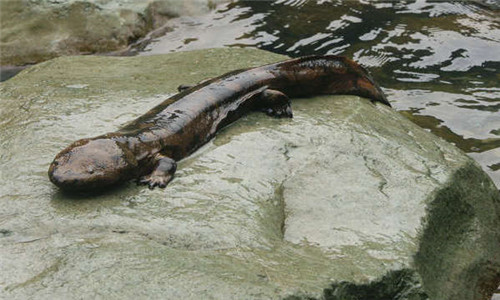
Chinese giant salamander
Chinese giant salamander (Andrias davidianus) farms risk the extinction of wild salamander populations instead of supporting their conservation, according to a new research led by international conservation charity Zoological Society of London (ZSL).
Researchers from ZSL and the Shaanxi Normal University, Xi'an, surveyed 43 farms in China and worked with the Shaanxi Province Fisheries Office to investigate the Chinese giant salamander farming industry. They found that, although only a decade old, the industry houses millions of animals and is a major contributor to the Chinese rural economy. The farming industry however, poses a number of threats to the Chinese giant salamander, but also has potential to benefit the species.
Wild salamanders are illegally poached to supplement farmed populations which often do not breed successfully. Farmed salamanders are traded across China and are kept in crowded conditions, both of which promote devastating disease outbreaks. Untreated wastewater from farms is discharged into local river systems, potentially spreading diseases to wild populations.
The Chinese giant salamander trade mixes locally-adapted genetic strains, making farmed animals unsuitable for future reintroduction to the wild.
Professor Andrew Cunningham, Professor of Wildlife Epidemiology at ZSL and lead-author of the paper, said: "The findings from our study identify measures that need to be taken to ensure the sustainability of Chinese giant salamander farming while also reducing threats to the remaining animals in the wild. With better farming practices, the Chinese giant salamander farming industry has the potential to benefit, rather than threaten, their conservation."
Chinese giant salamanders, the world's largest amphibian, are eaten as a delicacy in China. Their numbers have declined catastrophically over the past 30 years, largely due to overexploitation for food and habitat destruction. A rapidly growing number of farms, which supply salamanders for the restaurant trade, could be putting the future of this Critically Endangered species at risk.
Co-author Dr Samuel Turvey, Senior Research Fellow at ZSL, said: "We recommend complete separation of farmed and wild salamander populations, supported by the enforcement of existing legislation to stop the continued capture of wild individuals. Improved farming methods are required to remove any need to poach wild individuals, reduce disease risks to both farmed and wild salamanders, and to prevent genetic pollution of the wild salamanders."
Chinese giant salamanders are categorized as Critically Endangered on the IUCN Red List due to a drastic 80 percent decline in population over the last 30 years. This Evolutionarily Distinct and Globally Endangered (EDGE) species has been recognized as the number one priority for international amphibian conservation.
ZSL London Zoo is home to the UK's only Chinese giant salamander. Named after a project partner in China, 19 year-old Professor Wu measures over one meter in length and arrived in London at the end of November.
















































